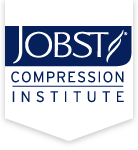Knowing how vein diseases impact the body is essential to understanding how compression therapy can manage each disorder. Each condition can have multiple impacts on a patient’s health.
Vein Disease Anatomy
Vein disorders occur when the body’s veins have been damaged. The damage is caused by a variety of factors ranging from lifestyle choices, such as being sedentary and smoking, to medical issues that include cancer, heart disease and blood-clotting disorders.
Vein diseases typically occur in the extremities, often in the legs. Many venous disorders can be linked to patients with a history of deep vein thrombosis, a condition causing blood clots to form in the legs and, therefore, block blood flow. This will lead to painful edema caused by the breakdown of the layers of collagen and elastin that make up blood veins’ walls that inhibit blood flow.
Venous disorders affect several veins throughout the circulatory system. Unlike arterial circulation, venous circulation disrupts the ability to pump blood back to the heart. In the case of DVT, if the blockage becomes dislodged it can travel through your circulatory system. This may lead to a pulmonary embolism, which can be fatal if it goes undetected.
Managing Vein Disease
Most vein diseases are not considered to be life-threatening conditions, and many can be controlled with management. The key to treating vein diseases lies in improving blood flow to the affected area. This can be accomplished several ways.
There are a few things to consider when determining how to manage the disease, including the patient’s age, symptoms, tolerance for various management options and the expected progress of the venous disorder.
- Compression Therapy: This is one of the most common approaches for venous disease management. Compression garments, like those supplied by JOBST®, improve blood flow. These garments, often called compression stockings, use gradient compression to apply pressure to the extremities. This helps improve blood flow and reduces recovery time for patients.
- Medication: Prescription medications are primarily used in conjunction with compression therapy when treating venous diseases. Medication may be used for treatment more often in cases where leg ulcers are present.
- Chemical Therapy: Chemicals are injected into the veins to cause scarring, leaving the vein unable to transport blood. The circulatory system automatically compensates to return blood to the heart through healthy veins, and the damaged veins are eventually absorbed.
- Surgery: Surgical procedures are performed to directly alter the blood flow away from damaged veins. Surgery may also be performed to repair, remove or transplant the affected veins.
Contact JOBST to Learn More About Compression Therapy
JOBST is a leading manufacturer of gradient compression garments throughout the world. To learn more about the garments we offer, please call us at 800-537-1063 or visit JOBST-USA.com.
Varicose veins affect half of Americans suffering from vein problems 50 years and older.
Source: "EPublications." Varicose Veins and Spider Veins Fact Sheet. Ed. Robert J. Min. Women's Health, US Department of Health and Human Services, 16 July 2012. Web. 18 June 2015.



